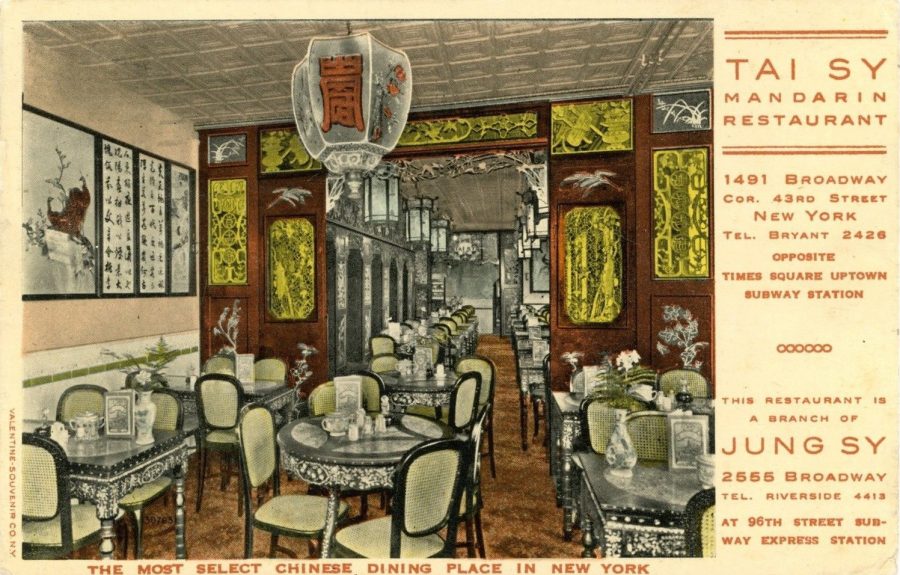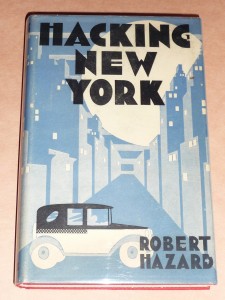Postcard Views 1910 – 1949 & A Short History Of Chinese Restaurants In New York City
Along with Chinese immigration to the United States in the 1850s, came Chinese food. It wasn’t long before Americans took a liking to the transoceanic cuisine. The Chinese population in New York City was only 747 in 1880. By 1900 it had grown to 6,321.
There “are eight thriving Chinese restaurants that can prepare a Chinese dinner in New York, almost with the same skill as at the famous Dan Quay Cha Yuen (Delmonico’s) of Shanghai or Canton,” according to Wong Chin Foo in the October 1888 Current Literature Magazine. With only one day off, Chinese patrons, usually working as laundrymen, would crowd the Chinese restaurants on Sunday’s.

Port Arthur Restaurant 7 & 9 Mott Street, considered among the finest Chinese restaurants in New York City est. 1899
In 1888, for a large group of Chinese, a first-class formal meal at a New York Chinese restaurant that could last up to two days and contain about 40 courses, cost $50. An inexpensive spread with eight courses was $8. For non-Chinese patrons to the neighborhood a meal for one would cost between five to twenty five cents.
Restaurateur and food aficionado George Rector late of the famous Rector’s on Broadway appreciated the Chinese style of cooking. In Dining With Rector in New York (1939, Prentice Hall). he contrasted French and Chinese cooking. “The Chinese way is to mix many ingredients in such a manner that no single one remains outstanding but all combine to produce a new flavor.” Rector astutely pointed out, “The French is counterpoint; the Chinese is harmony.”
Rector complimented Port Arthur Restaurant, 7-9 Mott Street, saying “the reputation of the place sustains is an indication of the excellence of its preparations.”
Restaurant critic George Chapell noted in The Restaurants of New York (1925, Greenberg) that Port Arthur’s “carved screens and golden dragon-work make it a splendid showplace.”
Lunch was 35 cents and dinner was 55 cents. After nearly eight decades in business, Port Arthur closed forever around 1975.
Chinatown At The Turn-Of-The-Century
Up until the late 19th century Chinese restaurants were found primarily in Chinatown. But by 1901 the New York Tribune reported that Chinese restaurants owned and operated by Chinese had expanded to uptown. The Tribune reporter discovered a Chinese cook could perform miracles with food, and would turn out as tasty as any French chef could produce.
The proprietor of any authentic Chinese restaurant would be happy to show any customer the proper use of chopsticks. The owner would then watch and laugh as the hapless customer usually failed at using the chopsticks.
Patrons were allowed to enter the kitchens if they wished to see how food was prepared. Diner’s were often surprised at the cleanliness of the kitchen. If they desired they could get into a pidgin English “conversation” with the chef.
Then of course the low price is what attracted many customers to try dishes such as pineapple chicken, chow chop suey, youkaman, chowman, hoi shum, sing ghee, boung gwee, sang ho – all served with unlimited quantities of rice and tea. Some customers did not eat at the restaurant but arrived with pails to be filled with food. This was the early version of Chinese take-out!
“Real” Chinese Food
By the 1920s Chinese restaurants, no longer a novelty, had become fixtures in most New York City neighborhoods. Many Chinese restaurants were staffed by Chinese but run by non-Chinese people, especially uptown. Some Chinese restaurants called themselves “Chinese-American” or vice versa to appeal to those who might want food not quite Chinese, like a hamburger or french fries.
George Rector complained about the authenticity of the Chinese-American cuisine. “Some of the Broadway Chinese restaurants are so much Westernized that they serve their dinners in courses in the Occidental style. Properly, each dish is a separate item, containing enough different ingredients with a mild enough flavor to be eaten in large amounts without becoming tiresome, and served in quantity sufficient in itself for an average meal.”
Hmmm, sounds like a description of most Chinese restaurants today.
The best and most authentic restaurants remained downtown in Chinatown centered around Mott and Pell streets.

Lee’s Restaurant, corner of Mott and 36 Pell St. Chinatown, 1930s “Oldest Chinese Restaurant in New York”
The restaurant with the longest run in the same location by the same family in New York was Lee’s, founded by Hong Lee, supposedly in 1892. According to Who’s Who of the Chinese in New York, published in 1918, Lee’s opened as Gui Yee Pen at 36 Pell Street in 1897, and later changed its name to Lee’s. Checking Trow’s New York Directory of 1903, the restaurant listed at that 36 Pell is indeed Guie Yee Quen & Co.
Food writer Lawton Mackall leads off the Chinese cuisine section with Lee’s restaurant as among his favorites in his 1948 book, Knife and Fork in New York Where to Eat What To Order (Robert M. McBride & Co.).
Mackall notes:
“Chinese family parties gather here, but they are outnumbered by hungry expeditionists from uptown, Brooklyn and Jersey. No sight-seeing bus passengers, however. Lee’s fried egg rolls are crisp marvels of deliciousness, cargoed with fresh-chopped seafood, etc. The Chinese green vegetable soup, the sweet and pungent spareribs, the fried shrimp with lobster sauce, the almond chicken chow mein, the lobster Canton style, the Chinese omletes of many kinds, the duck dishes, all have their devotees.”
Mackall concludes his summary by pointing out Lee’s is open seven days a week from 11 a.m. to 4 a.m. and is “always crowded.” Lee’s closed sometime in the 1960s ending its self-proclaimed run as oldest Chinese restaurant in New York.
While there was never an inventory done of exactly how many Chinese restaurants there are in New York City, it was estimated by Mackall that there were over 100 in the 1940s. That number seems extremely conservative based solely on the number of Chinese restaurants depicted in postcards. In 1938, Scudder Middleton, editor of Stage Magazine believed there were over 1,000 Chinese restaurants.

Among New York’s best Chinese restaurants was Lum Fong’s, with two locations, one at 220 Canal Street, the other at 150 West 52nd Street off of 7th Avenue. Lum Fong came to the United States in 1915 after establishing one of the most renowned restaurants in Canton. Lum Fong’s restaurants introduced many authentic Cantonese dishes to the American palate including moo goo gai pen.
In George Ross’ Tips on Tables Being A Guide to Wining and Dining in New York at 365 Restaurants Suitable to Every Mood and Every Pulse (1934, Covici Friede) the Canal Street Lum Fong has “excellent food.”
Ross writes “there is an unusual and exciting atmosphere about the place derived from the strange-looking patrons and the queer, steaming foods set before you.” Don’t bother to decipher the menu – ask Mr. Fong to order the meal.”
On February 12, 1936 at one of Lum Fong’s other restaurant’s, Lum’s at Lexington Avenue and 59th Street, a fire resulted in the death of nine people.
If you are wondering why Moe Levy’s clothing shop is featured in both of these postcards it is because Moe was Lum Fong’s not so silent partner.
Lum Fong died at the age of 66 on January 27, 1952. His restaurants outlived him closing in 1961.














Hello! Thanks so much for sharing this wonderful glimpse into NYC’s Chinatown history. Just wanted to let you know that Lee’s Restaurant was originally called Uie Ye Kwen (which translates to At Your Pleasure) according to Calvin Lee’s 1958 cookbook, Chinese Cooking for American Kitchens. Calvin was the grandson of Hong Lee, the original founder of Lee’s. According to Calvin the name was changed to Lee’s Restaurant in 1932 because the original name was too hard to pronounce for the caucasian and Jewish patrons who frequently dined there. I thought the reasoning behind this name change was also an interesting bit of cultural history, so wanted to include it here as well. Thanks again for writing such a fascinating post. – Katherine, In The Vintage Kitchen
There was an authentic Chinese Restaurant called Pomegranate in the early 70’s on Broadway.
Do you have any photos of the restaurant?
My father used to work in a midtown restaurant called China Song in the throughout the 1970s. Do you have any historic information about this restaurant?